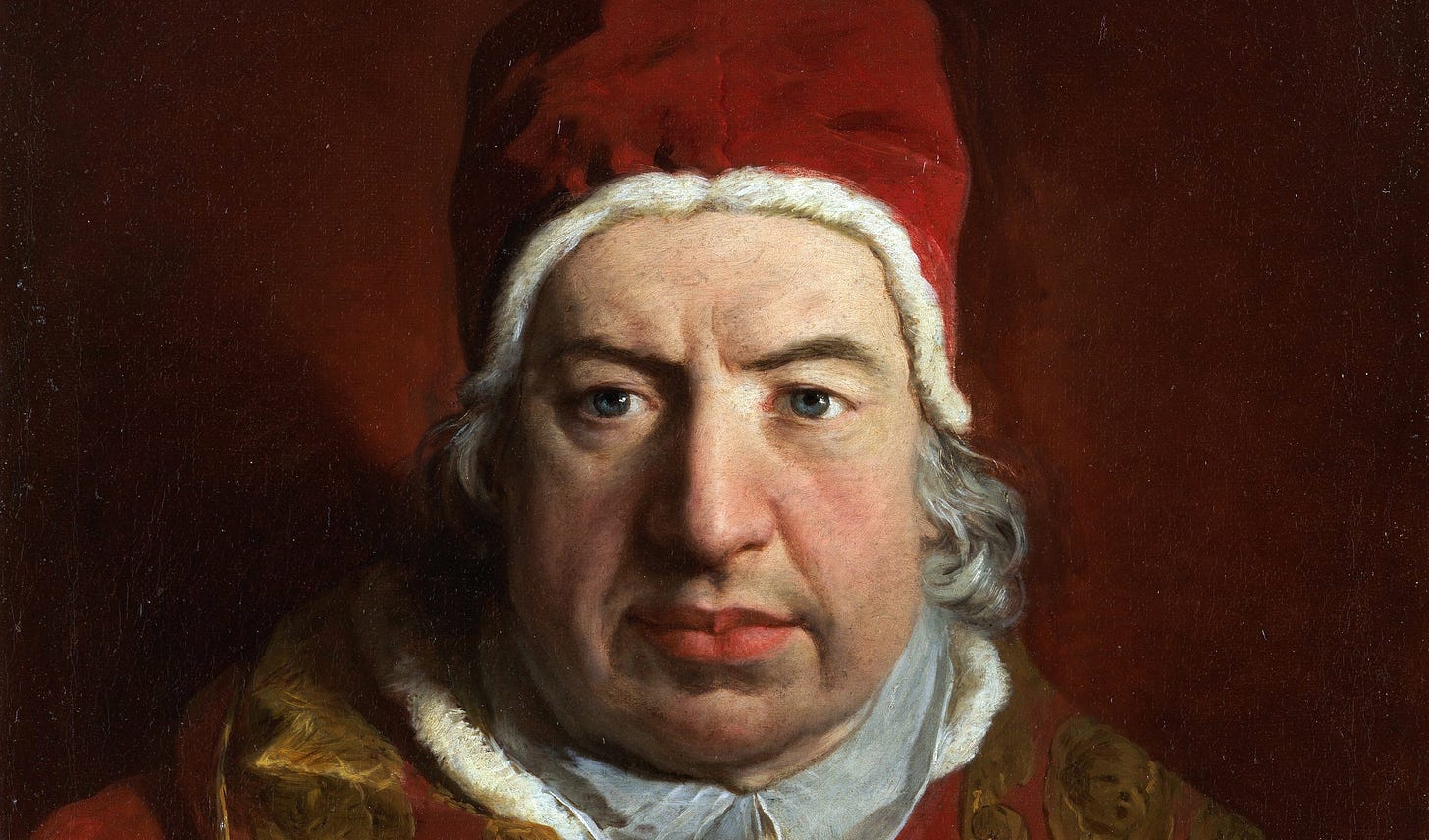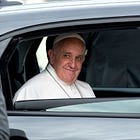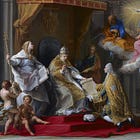Can a schismatic be a saint – or someone mistaken about the Pope's identity? Benedict XIV answers
In his treatment of 'false martyrs,' Benedict XIV considers whether schismatics can be saints and martyrs – and how we should see those who recognise a false pope, or reject a true pope.

In his treatment of ‘false martyrs,’ Benedict XIV considers whether schismatics can be saints and martyrs – and how we should see those who recognise a false pope, or reject a true pope.
Editor’s Notes
The following text is an excerpt of Pope Benedict XIV’s De Servorum Dei Beatificatione et de Beatorum Canonizatione, newly translated.
For more on Benedict XIV, his expertise on this subject, and the authority of this text, see Part I.
Having considered the status of non-Catholics in general and heretics in particular, Benedict XIV now turns his attention to schismatics. Under this heading, also considers what he calls “material schismatics.”
The terms “material schismatic” and “material heretic” are very slippery, as they are used in analogical ways that yield different meanings and different conclusions.
Some authors use these terms to apply to Catholics who err in good faith. A material heretic, in this usage, is one who is visibly submissive to the teaching authority (magisterium) of the Roman Catholic Church, but errs in good faith about what it teaches, and would correct his error when it is shown to him. A material schismatic is one who is submissive to the governing authority of the Roman Catholic Church, but errs in good faith about who constitutes this authority. Such men are commonly held to still be members of the Church.
However, other authors use these terms to refer to non-Catholics who err in good faith: for example, a Protestant, who is not submissive to the teaching or governing authority of the Church, but whose good faith precludes him from incurring moral guilt for this fact alone. Such men are commonly not held to be members of the Church.
Other still use it to refer to anyone who is not submissive to the Church’s authority, whether he be a putative Catholic, or an open non-Catholic. Such men – even the putative Catholics, if their non-submission is sufficiently public – are not held to be members of the Church, due to their rejection of the Church’s teaching or governing authority. This position has been defend by Matthew McCusker here.
Because of the divergent uses of the term, and the consequences which follow from each (particularly for membership and salvation), we must read and understand what a given author has written, in order to identify how he uses the term.
For example, Cardinal Louis Billot, for example, seems to use the term in the second (or perhaps third) way mentioned, and so concludes that material heretics are not members of the Church.
Benedict XIV, however, uses it in the first sense – as is clear from this text and the previous part. As such, his discussion and conclusions about material schismatics pertain to Catholics erring in good faith, and not to Protestants or Eastern Orthodox.
With this established, let us turn to the text.
On the False Martyrs of the Heretics and Schismatics
Benedict XIV’s On the Beatification of the Servants of God and the Canonisation of the Blessed
Chapter 20, from Book III, 1743
Part II
Schismatics in the proper sense cannot be saved
5. Thus far concerning heretics: now concerning schismatics. Schism therefore, insofar as it is distinct from heresy (which rarely happens), is nothing other than separation from the unity of the Church, according to the doctrine of Saint Thomas:
“Accordingly schismatics properly so called are those who, wilfully and intentionally separate themselves from the unity of the Church; for this is the chief unity, and the particular unity of several individuals among themselves is subordinate to the unity of the Church, even as the mutual adaptation of each member of a natural body is subordinate to the unity of the whole body.
“Now the unity of the Church consists in two things; namely, in the mutual connection or communion of the members of the Church, and again in the subordination of all the members of the Church to the one head, according to Col. 2:18, 19:
“‘Puffed up by the sense of his flesh, and not holding the Head, from which the whole body, by joints and bands, being supplied with nourishment and compacted, groweth unto the increase of God.’
“Now this Head is Christ Himself, Whose viceregent in the Church is the Sovereign Pontiff. Wherefore schismatics are those who refuse to submit to the Sovereign Pontiff, and to hold communion with those members of the Church who acknowledge his supremacy.”
‘Material schismatics’ – Catholics erring about the identity of the Catholic hierarchy – are a different case
6. In schismatics of this kind proceed those things which were said above: namely that one dying in schism cannot be a martyr, even if he dies for faith: for he dies outside the unity of the Church, and therefore cannot have eternal salvation.
But it sometimes happened that, when two were elected to the Supreme Pontificate and the whole Church was split into two factions, it was unknown which of them was legitimately elected. In this event of affairs, someone may have adhered to a man whom he thought the legitimate Pontiff, but whose election was afterwards judged not at all legitimate and canonical. He who so acts is not really a schismatic.
He would be a schismatic only in that case in which, after it was established by one having jurisdiction that the election of the one to whom he adhered was not at all legitimate, he nevertheless persisted in obedience to the same, and refused to obey the other, who had now been declared the legitimate Pontiff. This doctrine is of Antonius de Butrio in his Treatise on Schism, and Peter of Ancarano in certain Legal Allegations made by him for the Council of Pisa; and Silvester also agrees:
“But if it is established that one is canonically elected, but the other not; he who is not canonically elected, along with his followers knowingly, is excommunicated. But if it is doubted who is canonically elected, ignorance of fact excuses; ignorance of civil or canonical law – to which the discussion of this matter pertains – also excuses, if it is such that one can know neither through himself nor through others, since it deceives the most learned, and different people hold contrary opinions – although it does not excuse when it is such law that one can easily know through himself or through another, provided he has access to experts.”
(Summa at the word Schismatic, num. 7)
And Sanchez extensively pursues this in book 2 on the Decalogue chapter 36, num. 3 & 4; Cardinal de Lugo on Faith disput. 25, sect. 3, num. 36; Castropalao tome I on Charity tract. 6, disput. 4, punct. 5, num. 9. Therefore it happens that if such a one dies for the faith of Christ, he ought to be numbered among martyrs: for he conducts himself like one who received death for Christ, while he believed or taught some dogma, which was then disputed with impunity, but declared by the Church to be alien to faith, after his death.
In one word, just as a material heretic can be a martyr, so also a material schismatic. [Ed.: See the Editor’s Notes above for what is meant by these terms]
St Pierre of Luxembourg, Bl. Louis Allemand, and St Vincent Ferrer
7. Three examples especially seem able to support this assertion.
Pierre of Luxembourg and Louis Allemand were enrolled among the blessed by Clement VII the legitimate Pontiff, according to those things which were said by us in book 1, chapter 39, num. 4.
More can be read about Peter’s virtues in Spondanus, in his continuation of Baronius’s Annals, at 1387 AD, no. 3. As for the miracles worked by God through his intercession, further accounts are found in Baluze’s notes to the Lives of the Avignon Popes, vol. 1, p. 1320—despite the fact that Peter himself had been appointed to the college of cardinals by Robert of Geneva, the antipope who took the name Clement VII.
He died at barely eighteen years of age; and in fact, having made him a cardinal, the antipope Clement’s reputation gained no small increase as a result of the fame of Peter’s virtues and miracles. This is attested by Robert Gervasius, Bishop of Senez:
“But divine Providence approves and confirms those adhering to and obeying Lord Clement VII through the flashing of miracles, as appears concerning Lord Peter of Luxembourg, made cardinal by Lord Clement VII, by whose merits and prayers divine Providence works very many manifest miracles for those who believe in him.”
(Treatise on the Schism, fol. 52.)
Also, more can be read concerning Louis Allemand, or Alamannus, in his Life, tome 2, page 843; concerning whom Aeneas Silvius, who assumed the name Pius II when elevated to the pontificate, also says thus:
“In Arles, a great reputation for miracles has arisen at the tomb of Louis Cardinal of Saint Cecilia, bishop of that city, whom we saw presiding at Basel in the assembly of the Fathers; and a frequent concourse of invalids from everywhere has gathered there in hope of health.”
But Louis stood in the Council of Basel against Eugenius (the legitimate Pontiff), and consecrated Felix the Antipope; then, when he repented of what he had done, he returned to the obedience of Nicholas V (successor of Eugenius himself), and restored the unity of the Church – as is read in express words in the Gallican Martyrology on the 16th calends of October.
Finally, in the most foul schism between Peter de Luna (Benedict XIII) and Angelo Corario (Gregory XII) – who were deposed in the Council of Pisa, and subsequently deposed again at the Council of Constance (along with John XXIII), when Martin V was elected Supreme Pontiff – a great part of Spain venerated Peter de Luna (Benedict XIII) as true and legitimate Pontiff, but certain Italian cities equally adhered to Angelo Corario (Gregory XII) as to a true and legitimate Pontiff.
Saint Vincent Ferrer, having followed the party of Peter de Luna (Benedict XIII), and having also been the cause of the Kings of Aragon adhering to him, nevertheless persuaded King Ferdinand of Aragon to withdraw himself from his obedience, as soon as he began to see through his obstinacy and wicked artifices, and to publish an edict by which he strictly forbade his subjects to adhere to him as Pontiff under any pretext. So great was the fame of Saint Vincent’s sanctity, learning, and zeal for removing schism, that the Fathers of the General Council of Constance, assembled to remove the schism of those three contending for the pontificate, sent legates to ask him to come to the Council, if he could.
The letter sent to him exists in tome 2 of the Works of John Gerson, Chancellor of the Faculty of Paris, who had composed it, in the last Antwerp edition of the year 1706, page 658, and tome 1 of the New Treasury of Unpublished Documents of Father Edmund Martene, page 1749.
Conclusion: What these examples show us
Now, the first of the examples (St Pierre of Luxembourg) adduced shows that sanctity is not hindered if one, proceeding in good faith, has adhered to a Pontiff whom he believed to be legitimately elected, even though, after his death, his election was condemned. Of this kind is also the example of Saint Paschasius the Deacon and Confessor, whose mention is made in the Roman Martyrology on the 31st day of May. For he stood for Laurentius against Symmachus; and since Saint Gregory, in book 4 of the Dialogues chapter 40 & 41, relates that he persisted in his opinion until the day of his departure, it is to be believed that he departed from this life while the controversy over Symmachus’s election was still turning; as is noted by Cardinal Baronius in his Notes to the Martyrology on the said day.
From the second of the same examples (Bl. Louis Allemenad) it is made clear that sanctity is hindered, if anyone refuses to obey the legitimate Pontiff, if he does not repent of the deed before death.
Finally, from the third example (St Vincent Ferrer) it is deduced that he is not truly a schismatic, who, in a doubtful question of fact, adheres – together with many others holding a similar judgment – to a man whom he believes to be the legitimate Pontiff; from whom he nevertheless withdraws as soon as he perceives him not to be such.
Wherefore, just as a material schismatic in the aforesaid circumstances can be a Saint, so also he can be a Martyr, if he die for Christ and his Faith. [Ed.: Reminder to see the Editor’s Notes above for what is meant by the term “material schismatic”]
In the next part, Benendict XIV the false martyrs of the non-Catholic sects.
HELP KEEP THE WM REVIEW ONLINE WITH WM+!
As we expand The WM Review we would like to keep providing free articles for everyone.
Our work takes a lot of time and effort to produce. If you have benefitted from it please do consider supporting us financially.
A subscription gets you access to our exclusive WM+ material, and helps ensure that we can keep writing and sharing free material for all.
You can see what readers are saying over at our Testimonials page.
And you can visit The WM Review Shop for our ‘Lovely Mugs’ and more.
(We make our WM+ material freely available to clergy, priests and seminarians upon request. Please subscribe and reply to the email if this applies to you.)
Subscribe to WM+ now to make sure you always receive our material. Thank you!
Read Next:
Follow on Twitter, YouTube and Telegram:
Translated with the aid of AI, with each line scrutinised by a human person.




The situation today is more complicated, because we have false Popes who teach heresy and enact sinful and spiritually harmful disciplinary laws. Those who adhere to them should normally be considered as heretics and schismatics; but most (if not the great majority), only adhere to these men materially; and some such as the R&Rs even explicitly claim that their adherence and submission is conditioned on their teachings and discipline being Catholic.
Very good article.